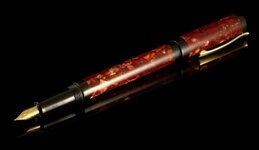yaroslaw
Member
Hi all!
Making kitless, what do you use usually for gluing different pieces of resin (accent pieces, clear windows, finials) together? I made my first one that style, and all pieces separated during drilling/turning. Without something supporting it, gluejoint on a thin wall is really weak Managed to save work, but it was so much extra work gluing pieces back concentric (as almost all work already been done on threads and everything)!
Managed to save work, but it was so much extra work gluing pieces back concentric (as almost all work already been done on threads and everything)!
Also, may be I used wrong order of steps? I've mounted main material in a collet, faced it, than glued accent piece (previously faced and cut slightly oversized) and than began to work with as a whole piece.
Result is pretty nice, but I don't want to repeat this experience once more

Making kitless, what do you use usually for gluing different pieces of resin (accent pieces, clear windows, finials) together? I made my first one that style, and all pieces separated during drilling/turning. Without something supporting it, gluejoint on a thin wall is really weak
Also, may be I used wrong order of steps? I've mounted main material in a collet, faced it, than glued accent piece (previously faced and cut slightly oversized) and than began to work with as a whole piece.
Result is pretty nice, but I don't want to repeat this experience once more


